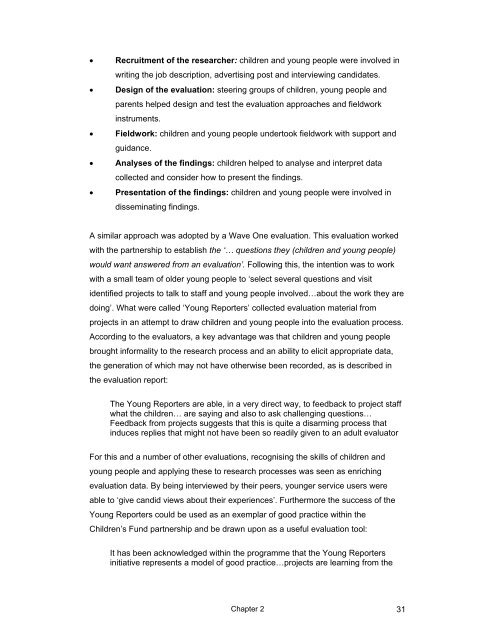Local Evaluation of Children's Services Learning from the Children's ...
Local Evaluation of Children's Services Learning from the Children's ...
Local Evaluation of Children's Services Learning from the Children's ...
- No tags were found...
You also want an ePaper? Increase the reach of your titles
YUMPU automatically turns print PDFs into web optimized ePapers that Google loves.
• Recruitment <strong>of</strong> <strong>the</strong> researcher: children and young people were involved inwriting <strong>the</strong> job description, advertising post and interviewing candidates.• Design <strong>of</strong> <strong>the</strong> evaluation: steering groups <strong>of</strong> children, young people andparents helped design and test <strong>the</strong> evaluation approaches and fieldworkinstruments.• Fieldwork: children and young people undertook fieldwork with support andguidance.• Analyses <strong>of</strong> <strong>the</strong> findings: children helped to analyse and interpret datacollected and consider how to present <strong>the</strong> findings.• Presentation <strong>of</strong> <strong>the</strong> findings: children and young people were involved indisseminating findings.A similar approach was adopted by a Wave One evaluation. This evaluation workedwith <strong>the</strong> partnership to establish <strong>the</strong> ‘… questions <strong>the</strong>y (children and young people)would want answered <strong>from</strong> an evaluation’. Following this, <strong>the</strong> intention was to workwith a small team <strong>of</strong> older young people to ‘select several questions and visitidentified projects to talk to staff and young people involved…about <strong>the</strong> work <strong>the</strong>y aredoing’. What were called ‘Young Reporters’ collected evaluation material <strong>from</strong>projects in an attempt to draw children and young people into <strong>the</strong> evaluation process.According to <strong>the</strong> evaluators, a key advantage was that children and young peoplebrought informality to <strong>the</strong> research process and an ability to elicit appropriate data,<strong>the</strong> generation <strong>of</strong> which may not have o<strong>the</strong>rwise been recorded, as is described in<strong>the</strong> evaluation report:The Young Reporters are able, in a very direct way, to feedback to project staffwhat <strong>the</strong> children… are saying and also to ask challenging questions…Feedback <strong>from</strong> projects suggests that this is quite a disarming process thatinduces replies that might not have been so readily given to an adult evaluatorFor this and a number <strong>of</strong> o<strong>the</strong>r evaluations, recognising <strong>the</strong> skills <strong>of</strong> children andyoung people and applying <strong>the</strong>se to research processes was seen as enrichingevaluation data. By being interviewed by <strong>the</strong>ir peers, younger service users wereable to ‘give candid views about <strong>the</strong>ir experiences’. Fur<strong>the</strong>rmore <strong>the</strong> success <strong>of</strong> <strong>the</strong>Young Reporters could be used as an exemplar <strong>of</strong> good practice within <strong>the</strong>Children’s Fund partnership and be drawn upon as a useful evaluation tool:It has been acknowledged within <strong>the</strong> programme that <strong>the</strong> Young Reportersinitiative represents a model <strong>of</strong> good practice…projects are learning <strong>from</strong> <strong>the</strong>Chapter 2 31
















